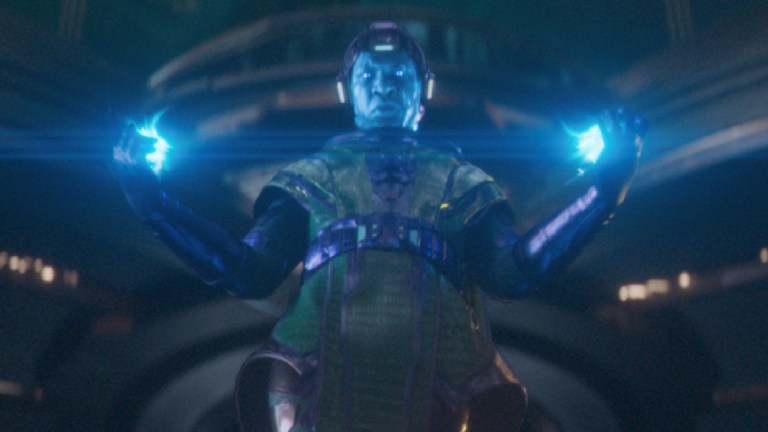Quantumania’s Kang the Conqueror Will ‘Affect Every Corner of the MCU’
Exclusive: Kang officially arrives in Ant-Man 3 and is going to be around for a long time, according to Marvel producer Stephen Broussard.

This article contains spoilers for Ant-Man and the Wasp: Quantumania.
“I have so many names…” Yes, that’s Al Pacino speaking as the titular fallen angel in The Devil’s Advocate. But the line may apply just as well to Kang the Conqueror, the new supervillain played by Jonathan Majors in Ant-Man and the Wasp: Quantumania, who’s poised to menace the Avengers and the MCU from now until at least 2026—when some kind of massive showdown will take place in Avengers: Secret Wars.
Of course regular MCU viewers have already met one version of Kang previously thanks to the last episode of the Disney+ series Loki. There he was billed as He Who Remains. His stated mission on that series? To keep the multiverse (and the multitudes of much more malevolent Kangs in them) contained. It’s also a goal which ended with his death at the hands of Loki variant Sylvie.
However, diehard Marvel Comics readers already know that there are many more alter-egos and variants of Kang, some of whom are glimpsed in the end credits scenes of Quantumania, including Immortus, Rama-Tut, Iron Lad, the Scarlet Centurion, Victor Timely, and others. Kang’s ability to travel through all of space and time and reality, hopping from universe to universe, makes him a particularly fearsome, unpredictable, and incredibly dangerous villain, which is why he’s stuck around Marvel since 1963.
That’s also what makes Kang’s official debut in Quantumania so ironic: The Ant-Man movies have been, until now, one of the MCU’s “smaller” franchises, focusing on self-contained, localized stories with little connection to the wider narrative of the universe. In this case, however, the idea of both introducing Kang as the next MCU big bad and doing so in an Ant-Man movie kind of came about simultaneously.
When asked about how the idea of introducing Kang into the MCU came about, Quantumania producer Stephen Broussard tells us, “The order was probably He Who Remains as an idea, as this person at the end of time, and then sort of folding it into the notion of him being some version of Kang, some version of Immortus, which was a character that had lived forever, is what we drew inspiration from—not exactly, but it’s kind of a little bit of a pastiche from the comic books.”
Broussard adds that once Marvel and director Peyton Reed (back for his third Ant-Man adventure) settled on the idea of spending most of the third Ant-Man picture in the subatomic mysteries of the Quantum Realm, the notion of discovering Kang there solidified.
“As we started to build that story out, when we looked at the mythology we were building, that was when the notion of Kang in this film came around,” the producer says. “We learned in Endgame that you go into the Quantum Realm to travel through time. The analogy we use is that the Quantum Realm is like the basement of the multiverse. That’s why [Kang] is banished here, because you can trap him. It’s outside of the multiverse, it’s outside of space and time. So we started to build on the ‘science’—I use quotation marks—of the MCU, about what the Quantum Realm is and who might be down there and why.”
Once it was established that Ant-Man/Scott Lang (Paul Rudd) and his team would collide with Kang in the Quantum Realm, thanks in part to a subatomic mapping device created by Scott’s daughter Cassie (Kathryn Newton) and in part to Janet van Dyne’s (Michelle Pfeiffer) own enigmatic connection to Kang, the question of where and when Kang could go next began to surface.
“Moving forward, the connectivity and where these films can talk to each other in exciting ways starts to come together,” Broussard explains. “That form follows the function of making something entertaining, aspiring to make a great series in Loki and aspiring to make a great movie in Quantumania.”
While Kang’s story has woven itself throughout the entire history of the published Marvel Universe, he does have one notable connection in the comics that bears closer scrutiny. Depending on what you’re reading and who you ask, Kang, whose real name in the comics is Nathaniel Richards, is either a far future descendant of the first Nathaniel Richards, father of the Fantastic Four’s Reed Richards, or a descendant of the Fantastic Four’s arch-nemesis, Doctor Doom.
With the Fantastic Four themselves set to debut in the MCU in 2025, kicking off Phase 6 and leading to Avengers: The Kang Dynasty and Avengers: Secret Wars, it’s worth asking whether those bloodline connections to Marvel’s First Family will play a role in the events that will unfold in either the Fantastic Four movie or the MCU in general.
“I don’t want to speak too specifically about what might or might not happen in that film [Fantastic Four],” says Broussard. “They obviously have an amazing rogues gallery, and the sky’s the limit with them. But Kang as a force, Kang as a plurality, feels very exciting to us, and I think there will be no corner of the MCU that won’t be affected by Jonathan and by Kang moving forward.”
Broussard adds in conclusion that he thinks Kang, the many versions of him, is unprecedented in terms of cinematic villains, in the MCU or otherwise.
“That feels very exciting to us, the idea of Jonathan playing these characters is very unique,” the filmmaker says. “I was just trying to think this morning about, like, is there anything comparable in movies, to this character playing radically different versions of the same person? It feels unique to explore and I’m glad we get to be the ones to do it.”
Ant-Man and the Wasp: Quantumania is in theaters now.
